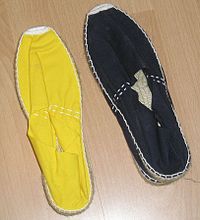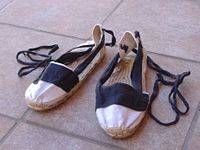Espadrille
The espargata or esparteña is a type of footwear spun from natural fibers such as cotton, animal skins, wicker or canvas with esparto grass, fique or hemp soles, or a mixture of jute and caranday (in Argentina), esparto (in Spain and other countries), which is secured by simple adjustment, a piece of elastic sewn to the fabric or with ribbons. It is used mainly in Spain, the south of France and various parts of America.
Description
Espadrilles are made using strong canvas, with jute or hemp rope soles. The espadrilles are very light, with good grip on the ground and very thin. Currently, its weaving has been industrialized and nylon threads and rubber soles are used, as well as with a canvas cover and a cocuiza or other vegetable fiber base. The espadrille is woven by hand on homemade triangular looms using wick (cotton thread), combining different colors. The sole can be made of tanned or cocuiza leather. It is made up of the upper part or capellá (upper part that covers the instep and the front part of the foot), “talonera” (part that forms the arch of the heel) and the “atadero” (also called “ correíta", which serves to hold the upper to the heel).
There is a great variety of types of espadrilles, fundamentally divided into two classes: those that adjust with ribbons and those that do not. It can also be divided between flats, like the traditional ones, and those with a high heel, which usually incorporate a wedge. At present it is frequent that the esparto sole is fully or partially covered with a thin layer of rubber, to protect them from humidity and wear.
Origin
It is believed that the espadrille originated from the Egyptian sandal, which later inspired the Romans to make a covered slipper to protect the foot from the sun and heat. In Europe they have been documented since at least 1322, the year in which a document written in Catalan describes the espardenyes “espadrilles” and mentions them with their current name in Catalan. In Catalan "slipper" It is also called espardenya.
At the same time, they were used in America before contact with Europe. The oldest record in America of an espadrille is part of a collection of items from the Anasazi culture in New Mexico (USA).[citation needed]
Traditional uses
Traditionally it has formed part of the typical costume in a good part of the countries of America and different regions of the Iberian Peninsula and the south of France. Specifically in Spain, its use was especially widespread in the territories of the former Crown of Aragon (Aragon, Catalonia, the Valencian Community and the Balearic Islands) as well as those of Castilian origin such as the Region of Murcia, Almería, Granada and in La Rioja and the cultural sphere. Basque (Basque Country, Navarre and French Basque Country). It is also traditional in Occitania (a country in the south of France), having its large production center in Mauleón, capital of the Basque-speaking French region of Sola. In Spain it was also widespread as urban worker footwear or even as footwear for soldiers, and today it is commonly used as an informal garment in the hottest months, in the same way as in Mexico, other Caribbean countries and the United States.
Both in Argentina and Uruguay, it is adopted by rural workers as a substitute for the colt boot. Unlike other garments, the humble espadrille became an essential garment for both sexes but, above all, the inseparable companion of the panties. Useful for those who could thus complete long hours in comfortable shoes, it has since been used as an ally for journeys in the summer rain by peasants and accompanied the rhythmic footsteps of popular dance. In the first half of the XX century, the use of espadrilles was so common among the lower classes of the population that it became very important the company called Fábrica Argentina de Espadrilles which used to be promoted with the artistic wall almanacs illustrated by Florencio Molina Campos. Espadrilles entered the Argentine political scene during the moments before the presidential terms of Juan Domingo Perón by being associated with the working class. In 1943 and 1944 the student movement opposed to Perón and the unions that supported his labor measures began to use the slogan: "no to the dictatorship of the espadrilles" which was in turn responded with the motto "sandals yes, books no".
In Argentina, day laborers' clothing or irreverent clothing has remained for cultural events, the espadrille has become the cheap and daily footwear of gauchos and countrymen; although the use of this comfortable and light footwear is frequent by the majority of the population when they are on vacation in warm areas of the country.
On the other hand, in Uruguay (where they are also for rural and artistic use) as well as in Chile and Peru it is commonly used in summer to go to the beach, or to carry out any outdoor activity. Because it is a cool shoe, it allows the foot to breathe, and adapts to its shape, being comfortable to carry out various activities. In Uruguay, espadrilles with rubber soles are also made, which are known commercially as rancheritas.
In Colombia it is part of the clothing of most of the typical costumes, being, in some cases, made of fique or cocuiza and in others made of leather. The inhabitants of the Orinoco river basin also make them in animal skin and call them "quotes" or cocuizas.
The espadrille is used interchangeably by men and women, although some may have varieties of edges and shapes of the fabric, as well as a "poppy" on the fabric, of a contrasting color, to differentiate them from those of universal use. Traditionalists maintain that this detail corresponds to the Wayúu indigenous culture of the La Guajira Peninsula, but it is alien to the tamunangue dance in Lara State, Venezuela, where footwear is typical of women's attire.
In Venezuela it is a light and comfortable shoe, very appropriate for the tropical climate, used mainly by the guajiros, although the espadrille is also used in the region of the Venezuelan plains and in many rural areas of the country.
Contenido relacionado
Panama flag
Festivities of Nuevo Leon
Lord of Miracles (Lima)






